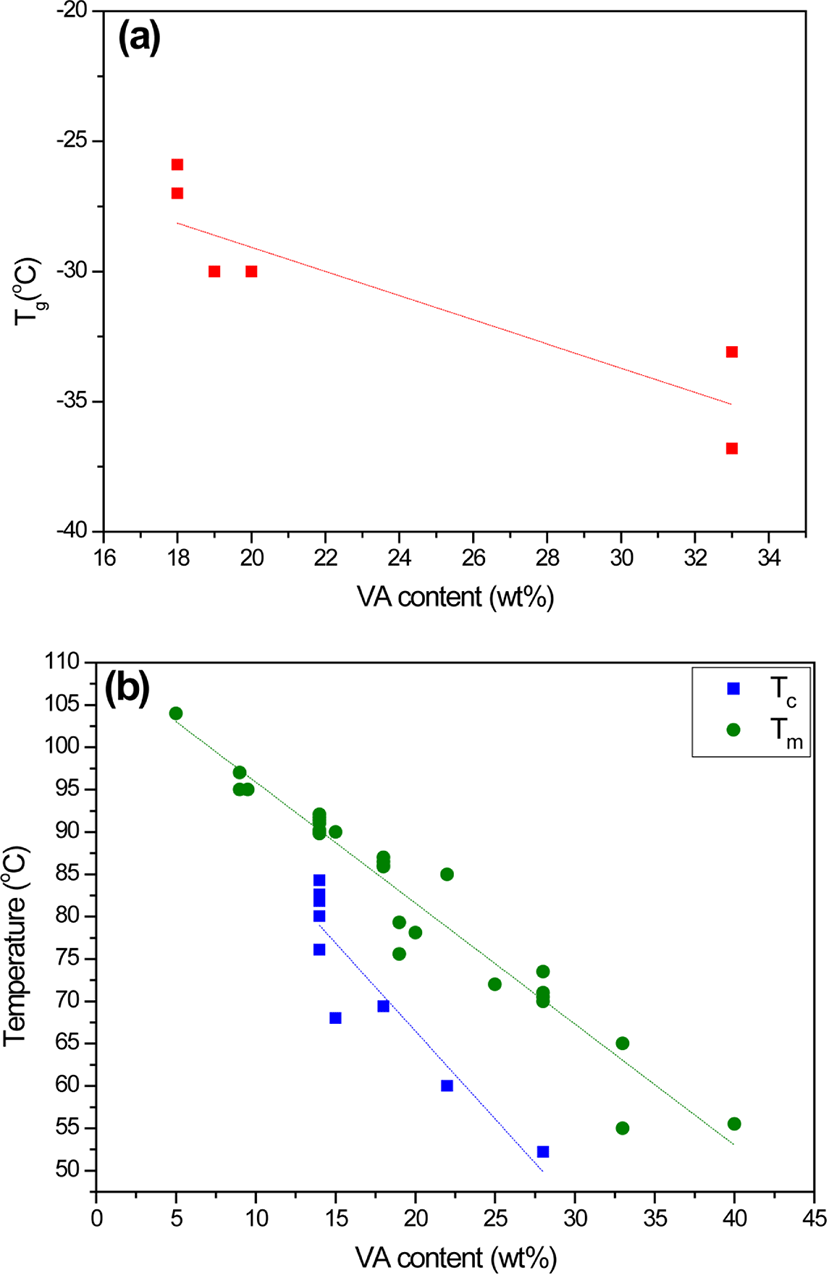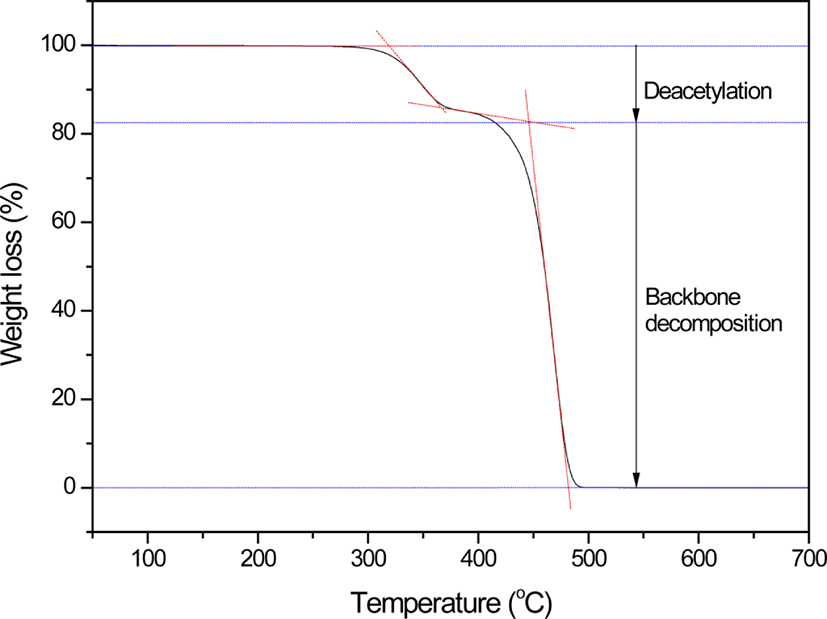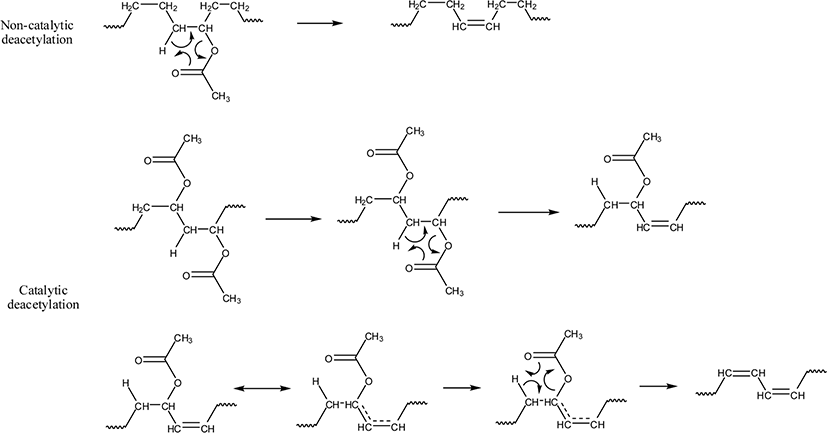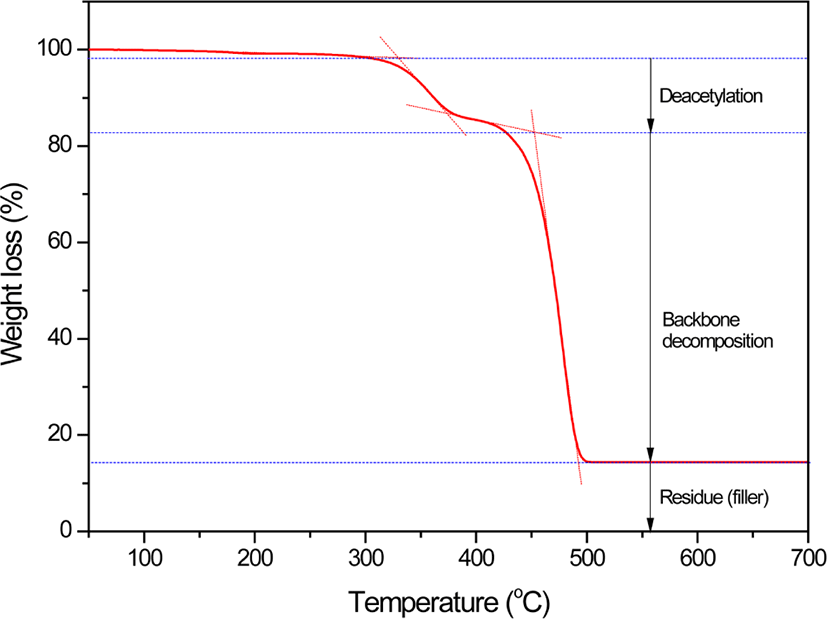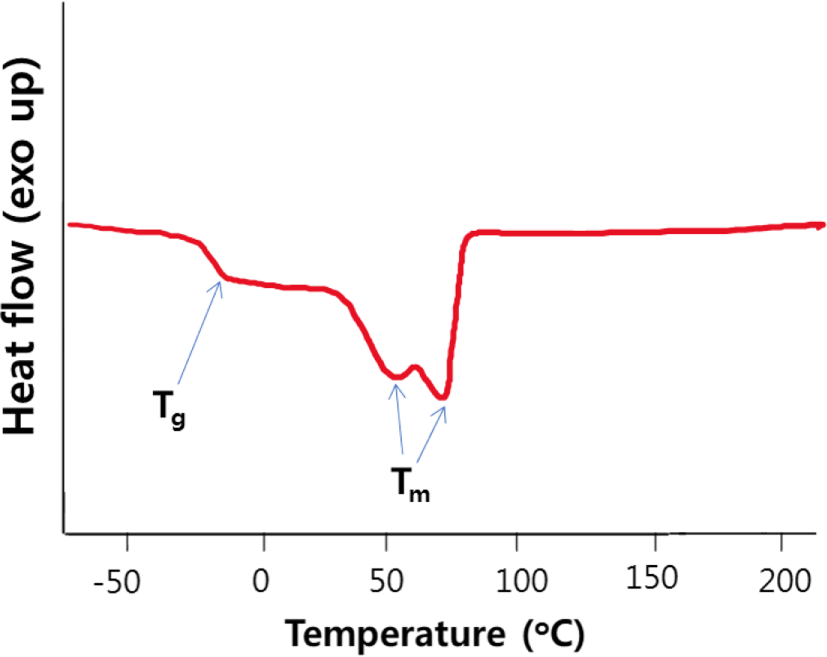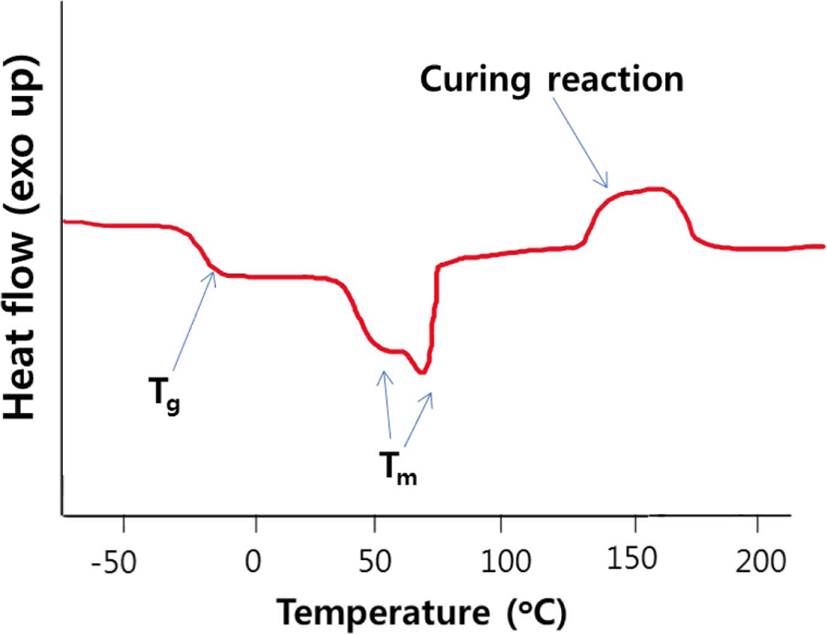Article
Characterization of Poly(ethylene-co-vinyl acetate) (EVA) Using Thermal Analytical Techniques
Chae Eun Son1, Sung-Seen Choi1,†
Author Information & Copyright ▼
1Department of Chemistry, Sejong University, 209 Neungdong-ro, Gwangjin-gu, Seoul 05006, Republic of Korea
© Copyright 2019 The Rubber Society of Korea. This is an Open-Access article distributed under the terms of the
Creative Commons Attribution Non-Commercial License (http://creativecommons.org/licenses/by-nc/4.0/) which permits
unrestricted non-commercial use, distribution, and reproduction in any
medium, provided the original work is properly cited.
Received: Feb 23, 2019; Revised: Mar 11, 2019; Accepted: Mar 13, 2019
Published Online: Jul 31, 2019
ABSTRACT
Poly(ethylene-co-vinyl acetate) (EVA) is a copolymer of ethylene and vinyl acetate (VA). It is im-portant to determine the VA content of EVA, since the properties of EVA depend highly on the VA content. EVA copolymers have been used in a wide range of applications appropriate for the different VA contents. IR, NMR, and TGA are generally used for determination of the VA content of EVA copolymers. Of these, TGA is the most reliable method and can be applied to cured EVAs. Analytical methods for determination of the VA content and properties of EVA copolymers via TGA were herein reviewed. Thermal behaviors of EVA copolymers (glass transition temperature (Tg), melting point (Tm), and crystallization temperature (Tc)) determined by DSC were also reviewed. Analysis of the related literature revealed that the Tg, Tm, and Tc decrease by about 0.46, 1.36, and 2.08°C, respectively, for every 1 wt% in VA content. A method for determining the degree of crosslinking of cured EVA copolymers was also reviewed, and the degree of crosslinking tends to increase with the decrease in the VA content.
Keywords: EVA; TGA; DSC; VA content; thermal behaviors
Various Applications of EVAs According to the VA Contents
Poly(ethylene-co-vinyl acetate) (EVA)는 에틸렌과 비닐아세테이트(vinyl acetate, VA)의 공중합체이다. EVA는 에틸렌 영역에 의해 결정성을, VA에 의해 비결정성 영역을 가지는 반결정성 고분자이다. EVA는 뛰어난 열안정성과 투명성, 그리고 VA함량에 따라 물적 특성이 달라지는 장점을 가지고 있어 다양한 VA함량을 가지는 EVA가 넓은 분야에서 사용된다. EVA는 원재료 자체로 이용되거나 충전제로 보강하여 사용하거나 다른 고분자와의 블렌드로 사용한다.
일반적으로 사용되는 EVA의 VA함량은 5-44 wt% 정도이다.1-11 EVA는 VA 함량에 따라 포장재, 태양전지, 케이블의 절연재부터 약물전달용 고분자까지 그 응용분야가 다양하다. VA함량에 따른 EVA의 응용 분야를 Table 1에 정리하였다. 14 wt% 미만의 VA 함량을 가지는 EVA는 고무의 탄성을 조절할 수 있는 필름으로써 가공되거나 저밀도 폴리에틸렌과 유사하게 아스팔트 개질제로 사용된다.1,2 15-28 wt%의 VA 함량을 가지는 EVA는 음식물 포장재와 같은 가정용 플라스틱이나 농업분야에서 사용된다.3-7 가공성이 좋고 산소와 수분투과성이 낮아 포장된 상품의 수분을 유지할 수 있고, 산소에 의한 부패를 막을 수 있기 때문이다. 열에 의해 EVA가 분해될 경우 차르(char)를 형성하는 성질 때문에 난연재로써도 쓰인다.8-10
Table 1.
Application Fields of EVAs According to the VA Contents.
| VA content (wt%) |
Properties |
Application Fields |
References |
| ≤ 14 |
High melting temperature, Chemical resistance, Brittleness |
Film, Asphalt modification |
1, 2 |
| 15-28 |
Medium transparency, Low gas permeation, Char production, High softness |
Food packaging, Agricultural industry, Intumescent systems |
3-10 |
| 30-33 |
High transparency, Good insulation |
Photovoltaic modules |
1, 11-15 |
| ≥33 |
Low melting point, Good solubility in organic solvent, Biocompatibility, Good flexibility, Adhesion property |
Cable sector adhesives, Drug delivery system |
1, 12, 16-21 |
Download Excel Table
VA함량이 30 wt%를 초과할 경우에는 녹는점이 낮고 용매에 쉽게 용해되기 때문에 접착제로서 가공된다.1,11 또한 VA 함량이 30 wt% 이상인 EVA는 태양전지에서 산란광을 제거하는 반사방지막(antireflection layer, AR layer)와 가장 외부에 존재하는 유리판 사이에 절연체로 사용된다.1,12-16 EVA는 반사방지막에 잘 부착될 수 있고, UV 투과도가 우수하며, 외부 유리기판과 반사방지막 간의 절연을 할 수 있으므로 태양전지에 탁월한 응용성을 보인다.12 하지만 태양전지의 가동이나 태양열에 의해 자외선과 열에 노출되어 EVA의 탈아세틸화 가능성이 존재하기 때문에 노화방지제나 자외선 흡수제 등의 첨가물을 같이 사용한다. 특히 자외선에 의한 노화는 자외선 안정제나 카본블랙을 이용하여 최소화 할 수 있다.16
인공장기 및 생의학 의료기기의 이용에 따라 외부물질이 체내에 주입될 경우 유발되는 혈전증을 치료하기 위한 접근법으로 고분자를 이용한 약물전달방법이 제시되었다.17,18 알코올로 잘 씻어낸 EVA는 체내에서 염증반응을 일으키지 않기 때문에 약물전달용 고분자로서 사용된다.19 Vasudev는 혈전증을 방지하기 위한 혈소판 억제제인 아스피린과 혈소판을 줄이기 위한 생체 활성제인 헤파린을 고분자 표면에 고정시키는 연구를 진행하였다.18 이외에도 호르몬이나 단백질을 전달하는데 사용된다.19-21 위 분야에는 일반적으로 VA함량이 약 40 wt%인 EVA가 사용되고 있다.
위와 같이 EVA는 VA 함량에 따라 다양한 특성을 구현할 수 있으므로 응용분야가 넓어 VA 함량을 정확하게 분석하는 것이 중요하다. 현재까지 열분석법과 분광법을 이용한 VA 함량 분석법이 개발되어왔다. 그 중에서 열중량분석법(thermo-gravimetric analysis, TGA)은 분광법에 비해 적은 오차를 가지고 전처리가 필요없어 VA 함량을 분석하는데 널리 쓰이고 있다.22-24 EVA는 VA함량이 감소할수록 에틸렌 영역에 의한 결정 영역이 증가하는 것으로 알려져 있다. 이러한 특성을 분석하기 위해 시차주사열량법(differential scanning calorimetry, DSC)나 동역학적 분석법(dynamic mechanical analysis, DMA)으로 분석하는 것이 일반적이다.
Analysis of the VA Contents of raw EVAs Using Spectroscopic Methods
1. Infrared spectroscopy (IR)
적외선분광법(IR)1,25-27이나 핵자기공명분광법(NMR)25,28,29과 같은 분광법으로 VA 함량을 분석할 수 있다. Koopmans는 1743 cm−1에서 나타나는 카보닐기의 피크를 이용하여 VA 함량을 분석하고자 하였다.27 하지만 두께가 50 μm 이상인 EVA 필름은 피크의 세기가 너무 강하게 나타나기 때문에 VA 함량을 계산하는 데 곤란하다. 이러한 문제를 극복하기 위해 Meszlenyi 등은 IR 스펙트럼에서 카보닐기로부터 생성되는 3460 cm−1의 흡광도와 (A3460), 에틸렌으로부터 생성되는 3610 cm−1의 흡광도(A3610)를 이용하였다.1 VA 함량이 다른 상업용 EVA를 IR로 측정하여 A3460/A3610 값을 구하고, 이를 VA 함량에 대한 검량선을 그려 VA 함량을 결정하였다. IR을 이용한 방법은 VA 함량이 정확히 결정되어 있는 표준시료를 이용하여 검량선을 작성해야 하기 때문에 표준시료가 없는 경우에는 좋은 분석 결과를 얻는 것이 곤란하다.
2. Nuclear magnetic resonance spectroscopy (NMR)
Poljansek는 NMR을 이용하여 유화중합 EVA의 에틸렌 함량을 분석하였다.29 에틸렌과 VA에 존재하는 양성자(H) 피크들의 면적을 질량분율로 환산하여 에틸렌 함량을 구하였으며, 이를 이용하여 VA 함량을 구할 수 있다. NMR을 이용한 방법은 표준시료가 없어도 측정이 가능하다는 장점이 있지만, 시료가 용매에 잘 용해되어야 하기 때문에 VA 함량이 매우 낮아 용해가 잘 되지 않거나 가교물에 대해서는 적용할 수 없다는 단점이 있다. Kim은 위와 같은 IR과 NMR, 그리고 TGA를 이용하여 EVA 내 VA 함량을 결정하였으며, TGA를 이용한 결과가 IR이나 NMR 분석 결과보다 오차가 더 작다는 것을 보고하였다.25
Analysis of VA Content of EVA Using TGA
1. Analysis of the VA contents of raw EVAs using TGA
열무게 분석법(TGA)은 EVA 원재료의 VA함량을 확인하기 위해 널리 사용되고 있다.24-26 EVA 원재료를 TGA로 분석하면 EVA의 VA함량을 결정할 수 있다. EVA에 열을 가하면 온도 상승에 따라 두 가지 과정을 통하여 열분해가 진행되어, TGA 열분석도에 두 단계의 무게감소가 일어난다(Figure 1).22-26 먼저 EVA 사슬 내 VA 단량체가 열분해 되면서 초산이 방출되고 그 자리에 이중결합이 생기는 탈아세틸화(deacetylation)이 일어난다. 탈아세틸화는 300-400°C 범위에서 일어난다. Rimez에 의해 보고된 바에 따르면, VA 단위체가 연속된 경우 탈아세틸화 반응에 의해 생성된 이중결합이 바로 이웃한 VA 단위체의 탈아세틸화 반응을 촉진시킨다(Scheme 1).28 이 과정에서 초산이 주로 생성되고, 부수적으로 이산화탄소와 물 분자가 생성된다. 이후 온도가 상승하면, EVA의 주쇄가 열분해되어 방향족과 지방족 휘발성 물질들이 생성된다.25,28 VA함량이 증가할수록 탈아세틸화 과정에 의한 무게 감소는 증가한다. 탈아세틸화 과정에 의한 무게감소와 식 (1)을 사용하여VA함량을 구할 수 있다.
여기서, WL(DA) (wt%)는 탈아세틸화에 의한 무게 감소이고, MW(VA)는 VA 단량체의 분자량(86.09 g/mol)이고, MW(AA)는 초산의 분자량(65.05 g/mol)이다. 여러 연구진들이 VA함량이 다른 EVA의 VA함량을 TGA로 우수하게 결정할 수 있음을 보고하였다.24-26
2. Analysis of EVA compounds using TGA
EVA는 투명성과 유연함 등의 고유 특징이 있지만 상대적으로 좋지 않은 열안정성 등의 단점이 있기 때문에 다른 고분자와 혼합하여 단점을 보완한다. Table 2에 EVA/PE, EVA/NR, EVA/PP, EVA/SBR 블렌드의 특성을 정리하였다.
Table 2.
Improvement of EVA by Blending with the Other Polymers.
| Blending polymer |
Improved properties |
Application Fields |
Reference |
| Polyethylene (PE) |
Chemical resistance, Ozone resistance |
Food packaging, Wire and cable insulation, Automotive industry, Multilayer packaging |
30-38 |
| Natural rubber (NR) |
Thermal stability insulation |
Cable insulation, Fire retardant materials, Rubber shoes, Automotive industry |
39, 40 |
| Polypropylene (PP) |
Impact strength |
Automotive industry |
42-45 |
| Poly(styrene-co-butadiene) (SBR) |
Thermal stability, Interfacial adhesion |
Automotive industry |
34, 46 |
Download Excel Table
PE는 오존저항성, 내화학적 특성과 물적 특성이 좋지만 응력 균열 저항성이 좋지 않다. EVA로 보강할 경우 응력 균열 저항성 뿐만 아니라 충격강도, 노화저항성, 저온유연성, 기체 투과성, 수분흡수성, 전기저항성이 좋아진다.30 일반적으로 PE는 LDPE와 HDPE로 나누어진다. LDPE는 가격이 저렴하고 유연성이 좋아 농산물의 포장재로 이용되고 있는 고분자이지만, 생분해성이 적어 토양오염에 영향을 줄 수 있다. 생분해성을 증대시키기 위하여 에센셜 오일을 가하고, 에센셜 오일의 휘발을 막기 위해 EVA를 섞어 제조하는 방안이 제시되었다.31 HDPE와 EVA를 섞어 이용할 경우 범퍼, 포장재, 와이어와 케이블 코팅과 같은 전기산업에 이용된다. Khonakdar는 LLDPE/EVA 배합물을 섞어 열 안정성을 평가하였다.32 LLDPE/EVA 배합물은 LLDPE와 EVA 보다 상대적으로 열 안정성이 증가하였다. 승온속도를 달리 하였을 때 열분해 경향도 보고하였는데, 10°C/min에서는 EVA의 탈아세틸화 반응의 무게감소가 나타난 반면 15, 20°C/min에서는 확연하게 나타나지 않았다. 폴리에틸렌/EVA 배합물의 VA함량을 결정할 경우에는 승온속도의 결정이 중요할 것으로 판단된다.
천연고무(NR)은 탄성이나 유연성과 같은 물적 특성이 좋아 타이어나 절연코팅에 많이 사용되고 있다. 천연고무와 EVA를 섞을 경우 천연고무에 의해 탄성특성이 좋아지고, EVA에 의해 내화학성이 좋아진다.40,41 두 고분자를 섞었을 경우 밀도가 감소하고, EVA에 의해 열안정성이 좋아지기 때문에 마찰열이 많이 가해지고 저밀도의 고분자가 요구되는 신발 분야나 자동차 분야에 이용된다.42 Sharif는 NR과 18 wt% 의 VA를 갖는 EVA를 섞었을 때의 열 안정성을 평가하였다.43 NR은 350°C에서 열분해가 일어난다. EVA와 같이 배합한 후 NR의 열분해는 상대적으로 높은 온도에서 일어났으며 더불어 EVA의 탈아세틸화 반응도 지연된다.
PP는 가전제품, 자동차 부품 등의 분야에서 자주 사용되는 고분자이지만 충격 강도가 낮고, 저온 혹은 고온에서의 물리적 특성이 좋지 않다. EVA를 섞을 경우 이러한 점을 보완할 수 있다.44,45 SBR은 충전제를 많이 가할 수 있고, 유연성과 탄성이 좋은 고분자이지만 열안정성이 좋지 않다.46 EVA를 섞었을 때 SBR과 EVA의 계면접착성에 의해 열안정성이 증가하는 경향이 있는데, 이러한 점은 천연고무와 유사하게 자동차 부품에 유용하다.34
EVA의 특성을 향상시키기 위해 카본블랙, 무기산, 클레이 등 다양한 충전제를 혼합하여 사용한다. 이들 충전제를 사용하였을 때 향상되는 특성을 Table 3에 정리하였다. EVA에 충전제를 섞은 배합물은 탈아세틸화 반응이 촉진되거나 주쇄의 분해반응이 지연되는 효과를 가져오는 등 원재료와는 다른 경향의 열분해거동을 보인다.22,23,36,47-55 EVA는 연소 시 유해한 기체와 연기가 덜 방출되며 차르를 형성하는 성질을 갖기 때문에 할로젠계 난연재의 대체제로서 이용될 수 있다. EVA-실리카를 캡슐화시켜 난연재로 이용할 때, 연소 시 실리카가 고분자를 둘러싸는 막을 형성하여 고분자의 연소를 지연시킨다는 보고가 있다.51 클레이는 EVA의 결정영역에 큰 영향 없이 VA의 상호작용에 의해 주로 비결정영역에 분산된다.54 이를 TGA로 분석할 경우 클레이의 수산화기에 의해 탈아세틸화가 촉진되지만, 라디칼 재결합반응(radical recombination), 일시적 가교결합 반응(transient crosslinking), Diels-Alder cyclo- addition 반응에 의해 연소가 지연된다.23 무기 충전제의 경우, EVA 배합물에 있는 충전제 함량은 Figure 2와 같은 TGA의 열분석도에서 EVA가 모두 분해된 후에 남은 잔여물의 무게비율을 통해 구할 수 있다.
Table 3.
Improvement of EVA by Reinforcing with Filler.
| Filler |
Improved properties |
Application Fields |
Reference |
| Carbon black |
Electronic conductivity, Elasticity |
Rail roads, electronic devices |
47-50 |
| Metal hydroxide |
Gas permission, Thermal stability |
Fire retardant materials |
22, 36, 51-55 |
| Clay |
Thermal stability |
Fire retardant materials |
23
|
| Cellulose |
Thermal stability, Tensile strength |
Food packaging, Barrier sheet |
56, 57 |
Download Excel Table
카본블랙은 EVA와 혼합하여 사용하면 태양광이나 열에 자주 노출되는 환경에서의 특성이 향상된다. EVA와 EVA/카본블랙(1%) 배합물을 노화시킨 후 분석한 결과 카본블랙을 섞지 않은 배합물에서 상대적으로 저분자량의 휘발성 물질이 많이 생성되었다.47 VA 함량이 32 wt%인 EVA에 40% CNT를 섞을 경우 EVA의 유연성에 전기 전도성이 보강된 수퍼커패시터로 응용할 수 있다.48 EVA-카본블랙 배합물의 경우, 질소 조건으로 EVA를 열분해한 후 산소 조건으로 변환하여 열분해 시키면 카본블랙이 연소된다. 이에 해당하는 무게감소를 이용하여 카본블랙 함량을 결정할 수 있다.
Analysis of Thermal Properties of EVA Using DSC
1. Characterization of thermal properties of raw EVAs using DSC
EVA의 열적 특성은 DSC를 이용하면 분석할 수 있다. 고분자가 가지는 결정들은 DSC로 측정하였을 때 그 결정이 융해되는 흡열반응을 한다. 결정 형태에 따라 흡열반응이 각기 다른 온도에서 일어난다. EVA 의 에틸렌 영역은 결정성을 띠지만 VA가 포함되어 있는 부분은 비결정성 영역을 띠고 있기 때문에 반결정성 고분자로 분류된다. EVA 사슬 내에 일정하지 않게 형성되어 있는 VA의 위치는 에틸렌 사슬의 결정 생성에 영향을 미친다. VA 함량이 많을수록 에틸렌 사슬이 격자를 형성하는 것을 방해하기 때문에 에틸렌 영역에 의한 결정성은 감소한다. 이에 따라 VA함량이 달라지면 유리전이온도(Tg), 결정화온도(Tc), 그리고 녹는점(Tm)이 다르게 나타난다. EVA가 응용되는 환경의 온도에 알맞는 결정특성을 가지는 EVA를 사용하였을 때 재현성과 안정성이 보장되기 때문에 이를 분석하는 것이 중요하다. EVA 원재료를 DSC로 분석하면, Tg, Tm, Tc에 대한 정보를 얻을 수 있다(Figure 3). DSC로 결정을 분석할 때에는 승온 과정을 통해 Tg와 Tm을 측정할 수 있으며, 냉각 과정을 통해 Tc를 확인할 수 있다.
EVA의 Tg는 영하에서 나타나기 때문에 Tg 이하의 온도에서부터 측정할 때 관찰이 가능하다. VA함량이 15-28 wt%인 EVA를 −85°C 부터 승온시켰을 때 약 -30°C에서 Tg가 나타나고, VA 함량이 증가할수록 Tg는 감소한다.34,37,41,58-60 반면 DSC로부터 Tg를 얻을 수 없는 경우도 존재한다. 이런 경우는 에틸렌 결정에 의해 유리전이온도가 나타나지 않을 수 있기 때문에 DMA에서 얻은 tan δ 값을 이용하여 측정하기도 한다.61
태양전지와 같이 넓은 온도범위에서 이용되는 EVA는 −40°C 이상의 유리전이온도를 가질 때의 기계적 특성에 영향을 끼쳐 전지모듈의 신뢰성과 안정성에 큰 영향을 주기 때문에 알맞은 Tg를 갖는 VA 함량을 선택하는 것이 중요하다.14Table 4는 문헌에서 얻은 EVA의 Tg, Tc, Tm을 종합한 것이며, Figure 4(a)는 이들을 VA 함량에 따라 도식한 것이다. Tg는 VA 함량에 따라 감소하는 경향이 뚜렷하다. Figure 4(a)의 곡선최적화 식이 y = −0.46x−19.80 (R2 = 0.73)이므로, VA 함량이 1 wt% 증가함에 따라 Tg는 0.46°C만큼 감소한다고 할 수 있다.
Table 4.
Glass Transition Temperatures (Tgs), Crystallization Temperatures (Tcs) and Melting temperatures (Tms) of EVAs According to the VA contents.
| VA content (wt%) |
Tg (°C) |
Tc (°C) |
Tm (°C) |
References |
| 5 |
- |
- |
104 |
61
|
| 9-9.5 |
- |
- |
95,97 |
35, 61, 67 |
| 14-15 |
- |
68, 68, 7, 76.1, 80.0, 82.6, 81.9, 84.3 |
90, 90.2, 91, 91.3, 91.7, 92.1 |
35, 61-64, 67-69 |
| 18-20 |
-25.9, -27, -30 |
69.4 |
75.6, 78.1 79.3, 85.9, 86, 86.5, 87 |
15, 34, 41, 58, 61, 62, 64 |
| 22 |
- |
60 |
85 |
68
|
| 25 |
- |
- |
72 |
64
|
| 28 |
- |
52.2 |
70, 70.5, 71, 73.5 |
61, 63, 64, 67 |
| 33 |
-36.8 |
- |
65, |
58, 64 |
| 40 |
- |
- |
55.5 |
61
|
Download Excel Table
Figure 4.
Variations of (a) glass transition temperature (Tg), (b) crystallization temperature (Tc), and melting temperature (Tm) of EVA with the VA content.
Download Original Figure
EVA는 [110]과 [200]의 두 가지 결정영역을 가지며, DSC 분석을 통해 두 가지 결정영역의 Tc를 확인할 수 있다.62,63 Shi는 14 wt%의 VA 함량을 가지는 EVA의 두 가지 Tc를 확인하였다. VA 함량이 14, 18, 28 wt%인 EVA를 분석하였을 때, VA함량이 높을수록 Tc와 Tm이 낮아진다고 보고하였다.63 Motta에 따르면, 14-33 wt%의 VA 함량을 갖는 EVA의 녹는점이 90-65°C에서 나타나고 VA 함량에 따른 녹는점은 선형적으로 변한다.64 반면 VA 함량이 44 wt% 이상이 되면 결정을 거의 띠지 않게 된다.65
Figure 4(b)의 Tc 도식에 대한 곡선최적화 식은 y = −2.08x + 108.02 (R2=0.83)이고, Tm 도식에 대한 곡선최적화 식은 y = −1.36x + 109.22 (R2=0.95)이다. 따라서, Tc와 Tm은 VA 함량이 1 wt% 증가함에 따라 각각 2.08°C와 1.36°C 만큼 감소한다고 할 수 있다. EVA가 결정을 형성할 때 에틸렌 사슬이 겹겹이 쌓여 라멜라 구조를 형성하며, 에틸렌 사슬의 길이가 길어질수록 결정을 잘 형성한다. VA 함량이 감소할수록 긴 에틸렌 사슬 구조에 의해 상대적으로 결정구조의 크기가 커지고, 결정화도가 높아지기 때문에 Tc와 Tm이 낮아진다. Okui에 따르면 EVA는 사슬이 겹겹이 쌓이는 사슬접힘 결정화(chain-folding crystallization)와 사슬접힘으로 쌓여진 결정들끼리 쌓이는 묶음 형태(bundle-like) 결정화가 일어난다.59 사슬접힘 결정화는 묶음 형태 결정화보다 상대적으로 높은 온도에서 일어나는데, VA 함량이 6 wt%에서 14 wt% 이상으로 증가할수록 사슬접힘 결정화가 더 우세하게 나타난다.59
반면 실험적 혹은 기기적 조건에 따라 녹는점이 다르게 측정될 수 있다. 사슬접힘 결정화는 결정화 시간에 따라 영향을 받지 않지만, 묶음 형태 결정화는 DSC를 이용한 결정화 시간에 따라 Tc가 다르게 나타난다. 이에 따라 DSC로 측정할 때 결정화 시간이 EVA의 녹는점을 측정함에 영향을 줄 수 있으며, 조건에 따라서는 한 개의 피크만이 보일 수 있다. 또한 Wang은 VA함량이 9.5 wt%인 EVA를 이용하여 10 nm부터 460 nm까지의 두께를 가지는 필름을 제조하였고, 두께에 따른 녹는점의 거동을 연구하였다.35 필름의 녹는점은 10 nm부터 300 nm까지는 큰 폭으로 상승하였고, 300 nm 부터는 소폭 증가하는 경향을 보였다. 냉각 속도에 따라 Tc 가 다르게 날 수도 있다. Voigt-Martin은 EVA를 천천히 냉각시키거나 빠르게 냉각(quenching)하여 냉각속도에 따른 결정화 영향을 조사하였다.66 오일 수조를 이용하여 EVA를 가열한 후 가열기를 끄는 방법으로 천천히 냉각시켰고, 빠르게 냉각시키기 위하여 시료를 드라이아이스/isopropanol 혼합물(-78°C)에서 냉각시켰다. 위 결과 천천히 냉각시킬 경우 중간길이의 곧은 결정이 형성되었지만, 빠르게 냉각시킬 경우 굉장히 짧고 구부러져있는 형태의 결정이 형성되었다. 이러한 경향은 DSC로 EVA의 결정을 분석할 때에 영향을 줄 수 있다.
2. Determination of degree of crosslinking of EVA compounds
EVA의 가교에는 일반적으로 dicumyl peroxide (DCP)와 같은 과산화물을 이용한다.11,71,72 가교도(degree of crosslinking)가 낮을 경우 완제품으로 성형하였을 때의 내구성이 상대적으로 떨어지기 때문에 가교도를 분석하는 것이 중요하다. EVA를 가교물로 가공할 경우 범용 고무에 비해 상대적으로 가교도가 좋지 않는데, 이는 EVA 내 에틸렌에 의한 결정영역에 기인한다. 가교도 분석 방법은 일반적으로 속실렛 추출법과 DSC를 이용할 수 있다.73-75Figure 5에 EVA 배합물의 DSC 열분석도를 제시하였다. DSC로 EVA 배합물을 분석하면 110-190°C에서 가교가 진행된다. 가교 시에 일어나는 발열반응과 식 (2)를 이용하여 가교도를 계산할 수 있다.73-75
여기서 DC 는 가교도, ΔHUC는 가교되지 않은 배합물의 가교반응 엔탈피, ΔHC는 가교된 배합물의 잔류 가교반응 엔탈피이다. 배합물에 가교제 등이 남아있지 않아 여분의 가교반응이 일어나지 않았다면 ΔHC는 “0”이므로 가교도는 100%로 나타난다. 따라서 DSC를 이용한 가교도 분석은 실제 가교 반응에 참여한 고분자 사슬의 백분율이 아니라 미반응 가교제 성분이 얼마나 남아 있는지를 결정하는데 이용하는 것이 타당하다.
가교반응은 EVA 내 에틸렌과 VA 단량체에 무작위로 일어나며, 에틸렌이 가교에 참여할 경우 에틸렌 결정을 쌓을 수 없는 구조로 되기 때문에 결정 영역이 줄어들 수 있다. Stark는 미가교된 EVA 배합물을 DSC로 측정하여 에틸렌 결정 특성을 확인하였다.75 DCP를 가한 EVA를 승온시켜 확인하였을 때 녹는점 2가지가 나타났으며, 130-180°C에서 가교에 의한 발열반응을 확인하였다. 첫 번째 승온 후 냉각시킨 뒤 다시 승온시켰을 때는 녹는점이 하나만 나타났다.
Acknowledgements
본 연구는 산업기술혁신사업[산업핵심기술개발사업](과제번호: 10048308)의 지원을 받아 수행되었으며 이에 감사드립니다.
References
References
G. Meszlenyi and G. Kortvelyessy, “Direct determination of vinyl acetate content of ethylene vinyl acetate copolymers in thick films by infrared spectroscopy”,
Polym. Test.,
18, 551 (1999).


I. A. Hussein, M. H. Iqbal, and H. I. Al-abdul-Wahhab, “Influence of M
w of LDPE and vinyl acetate content of EVA on the rheology of polymer modified asphalt”,
Rheol. Acta.,
45, 92 (2005).


D. Briassoulis, M. Hiskakis, E. Babou, S. K. Antihos, and C. papadi, “Experimental investigation of the quality characteristics of agricultural plastic wastes regarding their recycling and energy recovery potential”,
Waste Manage.,
32, 1075 (2012).



P. Appendini and J. H. Hotchkiss, “Review of antimicrobial food packaging”,
Innov. Food Sci. Emerg. Technol.,
3, 113 (2002).


A. C. Cameron, W. Boylan-Pett, and J. Lee, “Design of modified atmosphere packaging systems: modeling oxygen concentrations within sealed packages of tomato fruits”,
J. Food Sci.,
54, 1413 (1989).


Le-Bail, N. Hamadami, and S. Bahuaud, “Effect of high-pressure processing on the mechanical and barrier properties of selected packagings”,
Packag. Technol. Sci.,
19, 237 (2006).


M. Shafiee and S. A. A. Ramazani, “Investigation of barrier properties of poly(ethylene vinyl acetate)/organoclay nanocomposite films prepared by phase inversion method”,
Macromol. Symp.,
274, 1 (2008).


A. Riva, G. Camino, L. Fomperie, and P. Amigouet, “Fire retardant mechanism in intumescent ethylene vinyl acetate compositions”,
Polym. Degrad. Stab.,
82, 341 (2003).


F. Laoutid, L. Ferry, E. Leroy, and J. M. Lopez Cuesta, “Intumescent mineral fire retardant systems in ethylene–vinyl acetate copolymer: effect of silica particles on char cohesion”,
Polym. Degrad. Stab.,
91, 2140 (2006).


B. Li, H. Jia, L. Guan, B. Bing, and J. Dai, “A novel intumescent flame-retardant system for flame-retarded LLDPE/EVA composites”,
J. Appl. Polym. Sci.,
114, 3626 (2009).


I. O. Ucar, M. D. Doganci, C. E. Cansoy, H. Y. Erbil, I. Avramova, and S. Suzer, “Combined XPS and contact angle studies of ethylene vinyl acetate and polyvinyl acetate blends”,
Appl. Surf. Sci.,
257, 9587 (2011).


A. W. Czanderna and F. J. Pern, “Encapsulation of PV modules using ethylene vinyl acetate copolymer as a pottant: A critical review”,
Sol. Energy Mater. Sol. Cells,
43, 101 (1996).


C. Hirshl, M. Biebl-Rydlo, M. DeBiasio, W. Muhleisen, L. Neumaier, W. Scherf, G. oreski, G. Eder, B. Chernev, W. Schwab, and M. Kraft, “Determining the degree of crosslinking of ethylene vinyl acetate photovoltaic module encapsulants–A comparative study”,
Sol. Energy Mater. Sol. Cells,
116, 203 (2013).


K. Agroui, G. Collins, and J. Farenc, “Measurement of glass transition temperature of crosslinked EVA encapsulant by thermal analysis for photovoltaic application”,
Renew. Energ.,
43, 218 (2014).


M. D. Kempe, G. J. Jorgensen, K. M. Terwilliger, T. J. McMahon, C. E. Kennedy, and T. T. Borek, “Acetic acid production and glass transition concerns with ethylene-vinyl acetate used in photovoltaic devices”,
Sol. Energy Mater. Sol. Cells,
91, 315 (2007).


A. M. Henderson, “Ethylene-vinyl acetate (EVA) copolymers: A general review”,
IEEE Electr. Insul. Mag.,
9, 30 (1993).


R. Langer, “Polymetric delivery system for controlled drug release”,
Chem. Eng. Commun.,
6, 1 (1980).


S. C. Vasudev, T. Chandy, and C. P. Sharma, “Development of chitosan/polyethylene vinyl acetate co-matrix: controlled release of aspirin-heparin for preventing cardiovascular thrombosis”,
Biomaterials,
18, 375 (1997).


R. Langer and J. Forkman, “Polymers for the sustained release of proteins and other macromolecules”,
Nature,
263, 797 (1976).



J. Kost, J. Wolfrum, and R. Langer, “Magnetically enhanced insulin release in diabetic rats”,
J. Biomed. Mater. Res.,
21, 1367 (1987).



H. Creque, R. Langer, and J. Folkman, “One month sustained release of insulin from a polymer implant”,
Diabetes,
29, 37 (1980).



A. Marcilla, A. Gomez, and S. Menargues, “TG/FTIR study of the thermal pyrolysis of EVA copolymers”,
J. Anal. Appl. Pyrolysis,
74, 225 (2005).


M. C. Costache, D. D. Jiang, and C. Wilkie, “Thermal degradation of ethylene-vinyl acetate copolymer nanocomposites”,
Polymer,
46, 6947 (2005).


Z. Wenwei, Z. Xiaoguang, Y. Li, Z. Yuefang, and S. Jiazhen, “Determination of the vinyl acetate content in ethylene acetate copolymers by thermogravimedtric analysis”,
Polymer,
35, 3348 (1994).


S-S. Choi and E. Kim, “Comparison of vinyl acetate content of poly(ethylene-co-vinyl acetate) analyzed by IR, NMR, TGA”,
Elast. Compos.,
50, 18 (2015).


E. Ramirez-Vargas, D. Navarro-Rodriguez, A. I. Blanqueto-Menchaca, B. M. Huerta-Martine, and M. Palacios-Mezta, “Degradation effects on the rheological and mechanical properties of multi-extruded blends of impact-modified polypropylene and poly(ethylene-co-vinyl acetate) blends”,
J. Therm. Anal. Calorim.,
63, 748 (2001).

R. J. Koopmans, R. van der Linden, and E. F. Vansnat, “The characterisation of newly developed and promising hydrolyzed ethylene vinyl acetate copolymers”,
J. Adhesion,
11, 191 (1980).


B. Rimez, H. Rahier, G. V. Assche, and T. Artoos, “The thermal degradation of poly(vinyl acetate) and poly(ethylene-co-vinyl acetate), Part 1: Experimental study of their degradation mechanism”,
Polym. Degrad. Stab.,
93, 800 (2008).


I. Poljansek, E. Fabjan, K. Burja, and D. Kukanja, “Emulsion copolymerization of vinyl acetate-ethylene in high pressure reactor-characterization by inline FTIR spectroscopy”,
Prog. Org. Coat.,
76, 1798 (2013).


Y. Chen, H. Zou, M. Liang, and Y. Cao. “Melting and crystallization behavior of partially miscible high density polyeth-ylene/ethylene vinyl acetate copolymer (HDPE/EVA) blends”,
Thermochim. Acta,
586, 1 (2014).


K. Wattananawinrat, P. Threepopnatkul, and C. Kulsetthanchalee, “Morphological and thermal properties of LDPE/EVA blended films and development of antimicrobial activity in food packaging film”,
Energy Procedia,
56, 1 (2014).


H. A. Khonakdar, “Dynamic mechanical analysis and thermal properties of LLDPE/EVA/modified silica nanocomposites”,
Compos. Part B-Eng,
76, 343 (2015).


M. Faker, M. K. R. Aghjeh, M. Ghaffari, and S. A. Seyyedi, “Rheology, morphology and mechanical properties of polyethylene/ethylene vinyl acetate copolymer (PE/EVA) blends”,
Eur. Polym. J.,
44, 1834, (2008).


C. K. Radhakrishnan A. Sujith, and G. Unnikrishnan, “Thermal behavior of styrene butadiene rubber/poly(ethylene-co-vinyl acetate) blends TG and DSC analysis”,
J. Therm. Anal. Calorim.,
90, 11 (2007).


Y. Wang, S. Ge, M. Rafailovich, J. Sokolov, Y. Zou, H. Ade, L. Luning, A. Lustiger, and G. Maron, “Crystallization in the thin and ultrathin films of poly(ethylene- vinyl acetate) and linear low-density polyethylene”,
Macromolecules,
37, 3319 (2004).


Y. Cai, L. Song, Q. He, D. Yang, and Y. Hu, “Preparation, thermal and flammability properties of a novel form-stable phase change materials based on high density polyethylene/poly(ethylene-co-vinyl acetate)/organophilic montmorillonite nanocomposites/paraffin compounds”,
Energy Convers Manag.,
49, 2055 (2008).


H. A. Khonakdar, U. Wagenknecht, S. H. Jafari, R. Hassler, and H. Eslami, “Dynamic mechanical properties and morphology of polyethylene/ethylene vinyl acetate copolymer blends”,
Adv. Polym. Technol.,
23, 307 (2004).


S. Hobeika, Y. Men, and G. Strobl, “Temperature and strain rate independence of critical strains in polyethylene and poly(ethylene-co-vinyl acetate)”,
Macromolecules,
33, 1827 (2000).


S. Dalai and C. Wenxiu, “Radiation effects on HDPE/EVA blends”,
J. Appl. Polym. Sci.,
86, 553 (2002).


A. Sasikala and A. Kala, “Thermal stability and mechanical strength analysis of EVA and blend of EVA with natural rubber”,
Mater. Today Proc.,
5, 8862 (2018).


A. T. Koshy, B. Kuriakose, S. Thomas, and S. Varghese, “Studies on the effect of blend ratio and crosslinking system on thermal, X-ray and dynamic mechanical properties of blends of natural rubber and ethylene-vinyl acetate copolymer”,
Polymer,
34, 3428 (1993).


M. Kim, C. Park, S. R. Chowdhury, and G. Kim, “Physical properties of ethylene vinyl acetate copolymer (EVA)/natural rubber (NR) blend based foam”,
J. Appl. Polym. Sci.,
94, 2212 (2004).


J. Sharif, W. M. Z. W. Yunus, K. H. Dahlan, and M. H. Ahmad, “Natural rubber/poly(ethylene-co-vinyl acetate)-blend-based nanocomposites”,
J. Appl. Polym. Sci.,
100, 353 (2006).


A. K. Gupta, B. K. Ratnam, and K. R. Srinivasan, “Melt-rheological properties of PP/EVA blend”,
J. Appl. Polym. Sci.,
46, 281 (1992).


E. Ramirez-Vargas, D. Navarro-Rodriguez, A. I. Blanqueto-Menchaca, B. N. Huerta-Martinez, and M. Palacios-Mezta, “Degradation effects on the rheological and mechanical properties of multi-extruded blends of impact-modified polypropylene and poly(ethylene-co-vinyl acetate) blends”,
J. Therm. Anal. Calorim.,
63, 748 (2001).

C. K. Radhakrishnan, R. Alex, and G. Unnikrishnan, “Thermal, ozone and gamma ageing of styrene butadiene rubber and poly(ethylene-co-vinyl acetate) blends”,
Polym. Degrad. Stab.,
91, 902 (2006).


M. Copuroglu and M. Sen, “A comparative study of thermal ageing characteristics of poly(ethylene-co-vinyl acetate) and poly(ethylene-co-vinyl acetate)/carbon black mixture”,
Polym. Adv. Technol.,
15, 393 (2004).


Z. Zhang, W. Wang, C. Li, L. Wei, X. Chen, Y. Tong, K. Mai, and X. Lu, “Highly conductive ethylene-vinyl acetate copolymer/carbon nanotube paper for lightweight and flexible super capacitors”,
J. Power Sources,
248, 1248 (2014).


Y. Chen, J. Zhan, P. Zhang, S. Nie, H. Lu, L. Song, and H. Yuan. “Preparation of intumescent flame retardant poly(butylene succinate) using fumed silica as synergistic agent”,
Ind. Eng. Chem. Res.,
49, 8200 (2010).


M. Sabet, A. Hassan, and C. T. Ratnam, “Properties of ethylene–vinyl acetate filled with metal hydroxide”,
J. Elast. Plast.
47, 88 (2015).


D. Q. Tham, V. M. Tuan, D. T. M. Thanh, N. T. Chinh, N. V. Giang, N. T. T. Trang, T. T. X. Hang, H. T. Huong, N. T. K. Dung, and T. Hoang, “Preparation and properties of ethylene vinyl acetate copolymer/silica nanocomposites in presence of EVA-g-acrylic acid”,
J. Nanosci. Nanotechnol.,
15, 2777 (2015).



J. N. Asaad, N. N. Rozik, and S. H. Mansour, “Effect of surface modification of magnesium hydroxide on the flammability, mechanical and thermal properties of EVA/Mg(OH)
2 composites”,
Kgk-Kaut. Gummi Kunst.,
66, 49 (2013).

R. Sonnier, A. Viretto, L. Dumazert, M. Longerey, S. Buonomo, B. Gallard, C. Longuet, F. Cavodeau, R. Lamy, and A. Freitag, “Fire retardant benefits of combining aluminum hydroxide and silica in ethylene-vinyl acetate copolymer (EVA)”,
Polym. Degrad. Stab.,
128, 228 (2016).


M. Gelfer, C. Avila-orta, L. Liu, L. Yang, B. Chu, B. S. Hsiao, H. H. Song, M. Si, M. Rafailovich, and A. H. Tsou, “Manipulating the microstructure and rheology in polymer-organoclay composites”,
Polym. Eng. Sci.,
42, 1841 (2002).


A. I. Fernandaz, L. Haurie, J. Formosa, J. M. Chimenos, M. Antunes, and J. I. Velasco, “Characterization of poly(ethylene-co-vinyl acetate) (EVA) filled with low grade magnesium hydroxide”,
Polym. Degrad. Stab.,
94, 57 (2009).


S. Elanthikkal, U. Gopalakrishnapanicker, S. Varghese, J. T. Guthrie, and T. Francis, “Effect of cellulose whisker content on the properties of poly(ethylene-co-vinyl acetate)/cellulose composites”,
Carbohydr. Polym.,
95, 773 (2013).



E. K.Silviya, G. Unnikrishnan, S. Varghese, and J. T. Guthrie, “Thermal and mechanical characterization of EVA/banana fiber-derived cellulose composites”,
J. Appl. Polym. Sci.,
125, 786 (2011).


Y. Park, H. J. H. Kim, and Y. Lee, “Adhesion and rheological properties of EVA-based hot-meld adhesives”,
Int. J. Adhes. Adhes.,
26, 571 (2006).


N. Okui and T. Kawai, “Crystallization and ethylene/vinylacetate random copolymers”,
Makromol. Chem.,
154, 161 (1972).


M. A. Jacobs, M. F. Kemmere, and J. T. F. Keurentjes, “Foam processing of poly(ethylene-co-vinyl acetate) rubber using supercritical carbon dioxide”,
Polymer,
45, 7539 (2004).


A. Arsac, C. Carrot, and J. Guillet, “Determination of primary relaxation temperature and melting point of ethylene vinyl acetate copolymers”,
J. Therm. Anal. Calorim.,
61, 681 (2000).


X. Shi, J. Jin, S. Chen, and J. Zhang, “Multiple melting and partial miscibility of ethylene-vinyl acetate copolymer/low density polyethylene blends”,
J. Appl. Polym. Sci.,
113, 2863 (2009).


X. M. Shi, J. Zhang, J. Jin, and S. J. Chen, “Non-isothermal crystallization and melting of ethylene-vinyl acetate copolymers with different vinyl acetate contents”,
Express Polym. Lett.,
2, 623 (2008).


C. Motta, “The effect of copolymerization on transition temperature of polymeric materials”,
J. Therm. Anal.,
49, 461 (1997).


M. Shinoyama, S. Hayano, K. Matsukawa, H. Inoue, T. Ninomiya, and Y. Ozaki, “Discrimination of ethylene/vinyl acetate copolymers with different composition and prediction of the content of vinyl acetate in the copolymers and their melting points by near-infrared spectroscopy and chemometrics”,
J. Polym. Sci. B. Polym. Phys.,
36, 1529 (1998).


I. G. Voigt-Martin, “A Quantitative Electron Microscopic Study of the Crystalline Structure of Ethylene Copolymers”,
J. Polym. Sci. B. Polym. Phys.,
24, 1283 (1986).


R. Kuwahara, R. Tomita, N. Ogawa, K. Nakajima, T. Takeda, H. Uehara, and T. Yamanobe, “Crystallization and hardening of poly(ethylene-co-vinyl acetate) mouthguards during routine use”,
Sci. Rep.,
7, 1 (2017).




S. Park, C. Yim, B. H. Lee, and S. Choe, “Properties of the blends of ethylene-vinyl acetate and ethylene-α-olefines copolymers”,
Macromol. Res.,
13, 243 (2005).


G. Xu and K. Min, “Nonisothermal crystallization and melting behavior of EVA/OMWNTs nanocomposites”,
Polym. Plast. Technol. Eng.,
54, 390 (2014).


S. B. Yamaki, E. A. Prado, and T. D. Z. Atvars, “Phase transitions and relaxation processes in ethylene-vinyl acetate copolymers probed by fluorescence spectroscopy”,
Eur. Polym. J.,
38, 1811 (2002).


M. A. Bahattab, J. Mosnacek, A. A. Basfar, and T. M. Shukri, “Cross-linked poly(ethylene vinyl acetate) (EVA)/low density polyethylene (LDPE)/metal hydroxides composites for wire and cable applications”,
Polym. Bull.,
64, 569 (2010).


F. J. Pern, “Luminescence and absorption characterization of ethylene-vinyl acetate encapsulant for PV modules before and after weathering degradation”,
Polym. Degrad. Stab.,
41, 125 (1993).


C. Hirschl, M. Biebl-Rydlo, M. DeBiasio, W. Muhleisen, L. Neumaier, W. Scherf, G. Oreski, G. Eder, B. Chernev, W. Schwab, and M. Kraft, “Determining the degree of crosslinking of ethylene vinyl acetate photovoltaic module encapsulants-A comparative study”,
Sol. Energ. Mater. Sol. Cells,
116, 203 (2013).


Z. Xia, D. Cunningham, and J. Wohlgemuth, “A new method for measuring crosslink density in ethylene vinyl acetate-based encapsulant”,
Photovoltaics Int.,
5, 150 (2009).

W. Stark and M. Jaunich, “Investigation of ethylene/vinyl acetate copolymer (EVA) by thermal analysis DSC and DMA”,
Polym. Test.,
30, 236 (2011).


